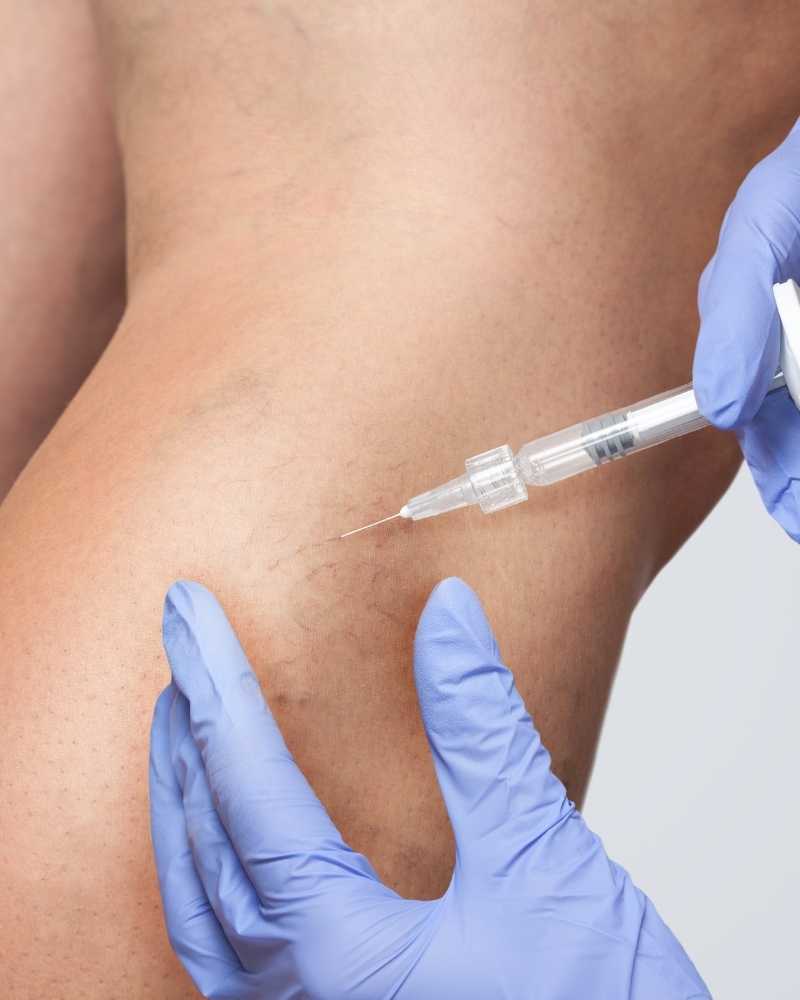Sclerotherapy
Are you bothered by tiny, thin, red, blue, or purple veins that take the shape of tree branches on your legs or other parts of your body? Sclerotherapy is exactly what the doctor will prescribe. Called spider veins or varicose veins, depending on their severity, these veins are not a danger to the patient’s health but many consider them to be unaesthetic. Fortunately, spider veins and varicose veins can now be treated using sclerotherapy.
Sclerotherapy is a minimally invasive procedure that uses a sclerosing agent to cut off the blood supply of the unwanted veins and redirect the flow of blood to healthier veins. The treatment of spider veins involves the injection of a solution that causes the incompetent veins to stick together, turn into scar tissue and eventually fade away.
Sclerotherapy is used to help patients who struggle with spider veins or varicose veins. However, it is less effective against damaged larger veins, as is the case with people suffering from advanced stages of varicose veins. The procedure is mostly used to treat spider veins on the legs, but it can also help treat affected veins that appear on the thighs, calves, ankles, face, and feet.
Am I a good candidate for sclerotherapy?
Sclerotherapy treatment can be recommended for the vast majority of people suffering from spider veins. However, there are cases when the procedure should be avoided. Women who are pregnant or breastfeeding should avoid getting sclerotherapy, as should women taking birth control pills.
The procedure is often performed on healthy people between the ages of 30 and 60, mostly because the condition becomes more visible as we age. Since varicose veins affect mainly the legs, sclerotherapy is more often used to treat the spider veins of women. However, it’s not unusual for men to develop the condition, although they don’t have to resort to sclerotherapy for cosmetic reasons.
Unfortunately, in some cases, spider veins and varicose veins can cause symptoms such as aching, swelling, burning, and night cramps. The best way to know if you are a good candidate for the procedure is to discuss your condition with a vascular specialist. They will do some blood tests and be able to pinpoint the cause of the problem. They can also tell you if the unhealthy veins are a symptom of a more serious condition, such as venous insufficiency.
What to expect during the procedure
The procedure is non-surgical and takes about 30 to 45 minutes depending on the severity of the condition. The medical provider performing the sclerotherapy will inject sclerosing solutions, such as polidocanol, sodium tetradecyl sulfate, or hypertonic saline solutions into the abnormal veins.
If the condition is more severe, the specialist performing the procedure may use an ultrasound to guide them. Patients may experience a little discomfort, such as minor stinging or cramping, but this usually happens in the cases of larger abnormal blood vessels.
If needed, the patient can receive local anesthesia. The specialist may perform ultrasound-guided foam sclerotherapy or use liquid sclerosing solutions, but the goal is the same: to seal the damaged veins and cause your body to absorb them. Sclerotherapy forces damaged veins to fade away or, in more severe cases, significantly reduces the appearance of varicose veins.
Aftercare
The procedure is minimally invasive. The patient may return to their normal activity on the same day. However, people who undergo sclerotherapy should have someone drive them home to avoid any unnecessary risks of infection. Wearing compression stockings or socks during the day when performing everyday activities is a must, and so is avoiding direct exposure to sunlight.
Patients are also advised to avoid taking hot baths or swimming for at least 2 days after sclerotherapy treatment and avoid taking aspirin or ibuprofen. Staying active after the procedure helps prevent the formation of blood clots but people should avoid strenuous exercise, such as running or weightlifting, for at least a couple of days after getting the injections.
Some bruising or marks at the injection site are normal and shouldn’t be a reason for concern. When used to treat spider veins, sclerotherapy helps remove the unsightly veins in 3-6 weeks, while larger veins respond to the injections in 3-4 months. A successful treatment session means the collapsed vein has been absorbed by local tissue and disappeared. If there are still signs of problematic veins on sight, the specialist may need to repeat the medical procedure.
Frequently Asked Questions


Reno’s Best Medspa
Aesthetics MedSpa is considered the best medical spa in Reno, Nevada! But don’t take our word for it. We’ve been named Reno’s Best Medical Spa 13 years running and were recently inducted into the Reno Business Hall of Fame. Check out all of our awards and recognitions as well as our raving customer reviews to learn why we’re Reno’s best Medspa.
We provide an extensive range of state-of-the-art treatments, highly qualified and experienced staff, personalized and comprehensive care, a luxurious atmosphere, and a commitment to patient satisfaction. By combining the latest technology with a focus on individualized treatment plans, Aesthetics MedSpa has established itself as the premier destination for those seeking top-notch cosmetic and wellness services in Reno.
